
New Release – STAAD.Pro CONNECT Edition V22 Update 10
I am pleased to announce a new incremental release of STAAD.Pro CONNECT Edition V22.
As part of our commitment to you to deliver new builds more frequently, we are making available this version which adds great new functionality to improve efficiency for engineers around the world and has resolved numerous issues that have been reported and thus highly recommend that you look to adopt this version and improve your working experience.
The principal developments and enhancements that are delivered in this new version of STAAD.Pro are:-
Physical Modelling
Physical Surfaces with Variable Thickness
There are many situations where a more efficient design can be achieved by more considered use of the quantity of material in the structural elements, such as walls and slabs, are constructed with a variable thickness. Structures such as retaining walls, cantilever canopy slabs or tank bases. STAAD.Pro analysis has supported finite elements with the variable thickness, but it can be tedious trying to define this at an element level. Better is to define a physical surface which includes the nature of the variability which is then automatically converted into the finite elements as the physical model is meshed.
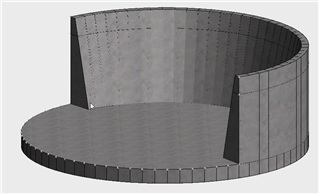
Making use of this enhanced surface attribute is a new template for creating tanks in the Physical Model Structure Wizard.
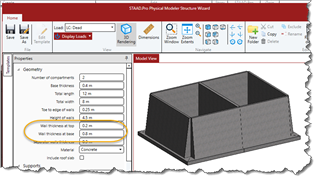
Analysis Attributes
Complimenting the recent ability to automatically generate the offsets in the analytical model of the surface alignment, a user configuration option has been added. This allows the engineer to decide whether the analytical model is best suited to include this data from the physical model, or simplify the model by using purely the node connectivity. This configuration can be set separately for surfaces and beams:-
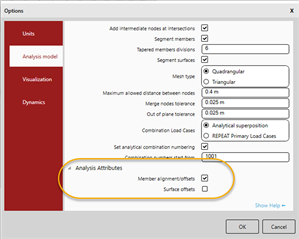
Reset Physical to Analytical data
The advantages of having a separate physical and analytical workflow have been borne out in many situations and is becoming a more accepted standard in engineering practice. The division of responsibility and management of data between the two workflows is proving to be a practical solution to improve efficiency of working on a physical model and retain control of the analytical data. However there are times when the data between these workflows needs to be reset. This is now provided as a simple additional tool in the model ribbon:-

Design Updates
The provision of design capabilities provided in STAAD.Pro has been enhanced with the following updates:-
AISC 360
A new module has been introduced in the Physical Model workflow that allows engineers to perform a single member design member to a variety of codes by providing a direct link to RAM S-BEAM(*). This module provides design of members to a variety of codes using either composite or non-composite methods
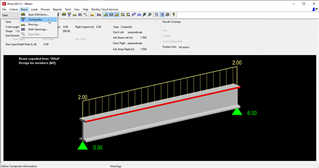
Data regarding length, and loading are passed to S-Beam and recorded as meta data in the physical model so it can be retrieved and modified in future.
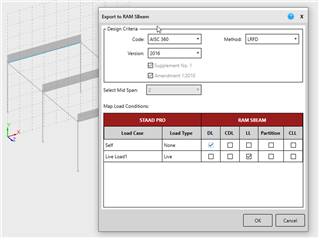
For those familiar with the RAM Structural System and RAM Elements offering will appreciate having a similar interop provided here from STAAD.Pro.
EN1993-1-1
The Eurocode 3 steel design module is one of the most commonly used post analysis designs used with a STAAD model. This has provided checks for all the standard profiles used in structural design, although one shape that has a growing adoption in structures where an advantage can be gained in using an I-section which has a web that tapers from the one end to the other, typically to account for an increase in applied moment. This is aided with the addition of a new design parameter, HGT, to assist in designers to specify the distance from the centroid of the purlins to the top flange.
Apart from the variable height of the profile at each of the 13 check positions, the key lateral torsional buckling check is implemented following the method outlined in Annex BB which limits the length between restraints.

Profiles defined as either Prismatic-I Section, from a Taper I Section User Table or from a Tapered pipe or tube are supported.
GB 50017
Continuing in the drive to widen the scope of support for design of structures to the Chinese steel code GB 50017, several enhancements have been provided which will further help designers improve their solutions. These include an improved section optimization based on weight and adding a capability to display the optimized weight of steel as a part of the Steel Design Results.
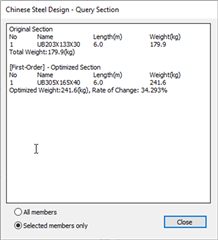
The routines that use the load case classification have been enhanced to also account for the recent addition of the category of ‘seismic-v’ for vertical seismic cases.

The rules provided in the Automatic Load Combination Generator for the Chinese combinations have been modified in GB50009-2012 to consider the vertical seismic load combination with horizontal seismic load. As well as adding a new load combination load file for GB:55002-2021.
Code check for general section
The most significant change has been with the introduction of support now for the design of members assigned GENERAL PRIMSMATIC profiles
Enhanced Wind Loading
One of the most popular loading generators used in STAAD.Pro is that which determines a loading pattern on a ‘face’ from a wind direction and pressure distribution that can change over height. The pressure profile can either be defined manually or by using one of the various codes included in STAAD.Pro. However, one of the limitations was that the pressure profile was based on the ground level being at a height of 0.0 in the model coordinate system. This may not always be the case. There are many models where the structure which could be subject to wind load could be below this level.
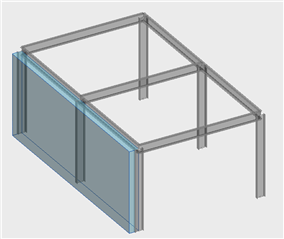
In addition, the method used to create the wind patterns following the requirements of the Chinese publication GB50011 have been enhanced to include options to include wind direction influence factors.
Chinese Response Spectrum Torsional Effects
The response spectrum routine that defines the curve according to the requirements to the Chinese GB50011-2010 code has been enhanced with an option to provide additional torsional effects using the method provided for the IBC and IS1893 design codes.
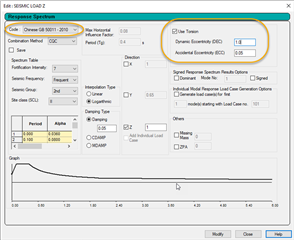
Interop
The digital twin solution service provided in the Physical Model workflow to assist structural engineers work more closely with the rest of the design team using iTwin Services will see an improved performance as design results are pushed to the iModel for design review.

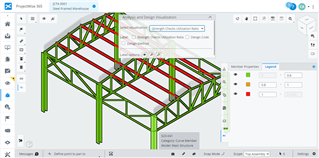
Note that this is currently being offered as an EAP. Get more details about this programme here, iTwin Services for Engineering Analysis Early Access Program (EAP) – RAM | STAAD Wiki – RAM | STAAD – Bentley Communities Contact your Bentley software provider to get more information on joining the EAP.
More Verification Examples
Adding more verification into the installation with samples to the Canadian CSA S16-19 and US, AISI 2016 codes.
Empty heading
Additional Modules
RCDC (**)
The Advanced Concrete Design application, RCDC, has been updated to v11.03 which includes: –
1. Design of Columns, Shear Walls, Beams, Footings, Pile-caps and Slabs as per ACI 318-19 (English units).
2. Update Footing Design will help users to check the existing design against forces from revised analysis. The change in analysis file can be related to geometry of structure or members or it can be change in Loading data. This feature is available to all design codes available in RCDC.
3. Different Reinforcement Grade for Main and Secondary reinforcement for Beam module
For more details on these and other issues that have been addressed in this build Refer to the RCDC Release Notes.
For more details on these and other issues that have been addressed in this build Refer to the SFA Release Notes.
(* Requires separate RAM SBeam license)
(** RCDC requires additional license, however, it is included with STAAD.Pro Advanced and Structural Worksuite)
Note that if you are already using STAAD.Pro CONNECT Edition, you should be notified of the new build with the Bentley CONNECTION Client.
